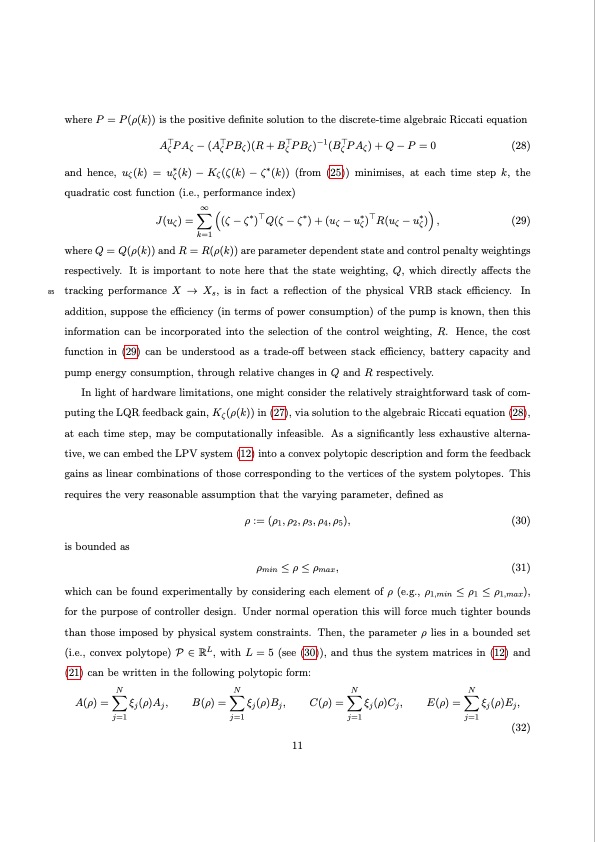
PDF Publication Title:
Text from PDF Page: 011
where P = P (ρ(k)) is the positive definite solution to the discrete-time algebraic Riccati equation ⊤ ⊤ ⊤−1⊤ AζPAζ −(AζPBζ)(R+BζPBζ) (BζPAζ)+Q−P =0 (28) and hence, uζ(k) = u∗ζ(k) − Kζ(ζ(k) − ζ∗(k)) (from (25)) minimises, at each time step k, the quadratic cost function (i.e., performance index) ∞ J(uζ)=(ζ−ζ∗)⊤Q(ζ−ζ∗)+(uζ −u∗ζ)⊤R(uζ −u∗ζ), (29) k=1 where Q = Q(ρ(k)) and R = R(ρ(k)) are parameter dependent state and control penalty weightings respectively. It is important to note here that the state weighting, Q, which directly affects the 85 tracking performance X → Xs, is in fact a reflection of the physical VRB stack efficiency. In addition, suppose the efficiency (in terms of power consumption) of the pump is known, then this information can be incorporated into the selection of the control weighting, R. Hence, the cost function in (29) can be understood as a trade-off between stack efficiency, battery capacity and pump energy consumption, through relative changes in Q and R respectively. In light of hardware limitations, one might consider the relatively straightforward task of com- puting the LQR feedback gain, Kζ (ρ(k)) in (27), via solution to the algebraic Riccati equation (28), at each time step, may be computationally infeasible. As a significantly less exhaustive alterna- tive, we can embed the LPV system (12) into a convex polytopic description and form the feedback gains as linear combinations of those corresponding to the vertices of the system polytopes. This requires the very reasonable assumption that the varying parameter, defined as ρ := (ρ1, ρ2, ρ3, ρ4, ρ5), (30) is bounded as ρmin ≤ ρ ≤ ρmax, (31) which can be found experimentally by considering each element of ρ (e.g., ρ1,min ≤ ρ1 ≤ ρ1,max), for the purpose of controller design. Under normal operation this will force much tighter bounds than those imposed by physical system constraints. Then, the parameter ρ lies in a bounded set (i.e., convex polytope) P ∈ RL, with L = 5 (see (30)), and thus the system matrices in (12) and (21) can be written in the following polytopic form: NNNN A(ρ) = ξj(ρ)Aj, B(ρ) = ξj(ρ)Bj, j=1 j=1 C(ρ) = ξj(ρ)Cj, E(ρ) = ξj(ρ)Ej, j=1 j=1 (32) 11PDF Image | Electrolyte Flow Rate Control Vanadium Redox Flow Batteries

PDF Search Title:
Electrolyte Flow Rate Control Vanadium Redox Flow BatteriesOriginal File Name Searched:
2201-12812.pdfDIY PDF Search: Google It | Yahoo | Bing
Salgenx Redox Flow Battery Technology: Salt water flow battery technology with low cost and great energy density that can be used for power storage and thermal storage. Let us de-risk your production using our license. Our aqueous flow battery is less cost than Tesla Megapack and available faster. Redox flow battery. No membrane needed like with Vanadium, or Bromine. Salgenx flow battery
| CONTACT TEL: 608-238-6001 Email: greg@salgenx.com | RSS | AMP |